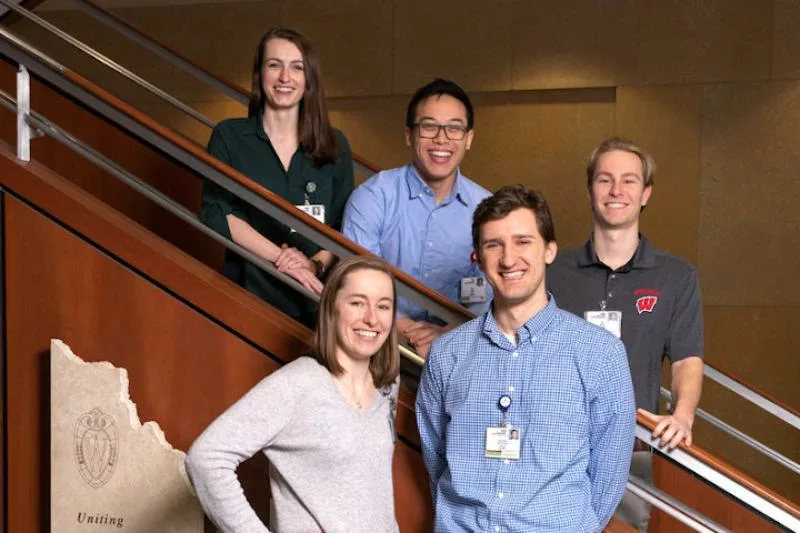Three Incredible Months in 1955
Alumnus Ralph Olsen shares his experience living through the Wisconsin polio outbreak of 1955.
If you ask a doctor to suggest ways to improve the health-care system, you may be listening for a while. Physicians and other health-care providers are in prime positions to recognize areas where current practices fall short. Although they frequently see opportunities to make enhancements, these ideas often aren’t cultivated to fruition because the providers may lack the time, knowledge or training needed to move from an insight to a meaningful change.
The Technology, Entrepreneurs Changing Healthcare (TECH) Student Interest Group at the University of Wisconsin School of Medicine and Public Health is looking to bridge that gap by providing medical students with early firsthand opportunities to experience the medical innovation process. In spring 2020, a new collaboration between the School of Medicine and Public Health and the Department of Biomedical Engineering in the UW–Madison College of Engineering is set to do just that.
Students are increasingly engaging at the intersection of medicine and technology, and many are seeking avenues to participate in innovation on campus, at UW Health and in the community. TECH recognizes that a physician-innovator mentality is taking hold in medical schools.
Joshua Medow, MD (PG ’00, ’06), PhD ’19, an associate professor in the UW Department of Neuroscience and a physician-innovator, told medical students at a recent TECH meeting that they have a unique perspective when interacting with innovation. They know just enough information to speak the language of medicine, but not so much that they have performed a task or procedure the same way a hundred or more times. Therefore, it is easy for them to look at medicine through a lens of inquiry.

Medical students who develop an inquisitive nature and entrepreneurial skill set early in their careers will be well equipped to make valuable changes in a technology- and product-driven health care environment. Like physicians, however, medical students may overflow with interest, talent and diverse perspectives, yet lack the time and resources to start projects on their own.
As the incoming TECH leaders of 2020, we want to provide students with an approachable way to get familiar with the product design process, learn to work with an interdisciplinary team of subject-matter experts, and understand basic go-to-market strategies.
Of the five current TECH leaders, four have engineering backgrounds, and three are biomedical engineering alumni. Their memories of the valuable engineering design experiences they had as undergraduates sparked an idea that resulted in an exciting TECH partnership with the Biomedical Engineering’s Design Curriculum. The partnership launched in February 2020 when School of Medicine and Public Health students were paired with undergraduate engineering design teams. This gave medical students the opportunity to collaborate on established medical innovation projects.
The Biomedical Engineering Design Curriculum focuses on finding feasible solutions for real-world problems. Each semester, physicians, faculty, community members and health care companies propose projects for biomedical engineering undergraduate students to work on from their sophomore year through their senior year. The students then form teams and select the projects that fit their interests and skills.
These projects are diverse and span many health-care fields; they include developing prototypes for medical devices, creating software applications for new imaging modalities, and modifying diagnostic tools. While these projects are assigned every semester, projects often continue for several semesters to reach completion. Past projects have resulted in publications, patents and further development to take products to market.
In the spring 2020 semester, we have 27 interested medical students and 10 biomedical engineering design projects. Examples include:
As design team members and consultants, medical students provide valuable medical context and help facilitate student-physician communications. In return, they gain a firsthand introduction to the engineering design process. We expect many benefits for medical and engineering students who participate in this collaboration. Medical students can:
Engineering students can:
Medical students participating in this collaboration are eager to engage with engineers and innovation projects.
Nick Arp, a first-year School of Medicine and Public Health student mentioned, “As a medical student with no prior experience in engineering, the new TECH partnership with the Department of Biomedical Engineering will be a great experience to introduce me to the field of biomedical engineering and the process of medical device design. The collaborative and interdisciplinary nature of the partnership will be a unique learning experience for all of us. In particular, the two-way street of communication will be crucial for all involved to understand medicine and engineering.”
We are excited and hopeful for the inaugural round of the School of Medicine and Public Health-TECH and Biomedical Engineering Design Program’s partnership. Pending its success, we hope to create this type of partnership with other health professions and entrepreneurial bodies on campus and in Madison.